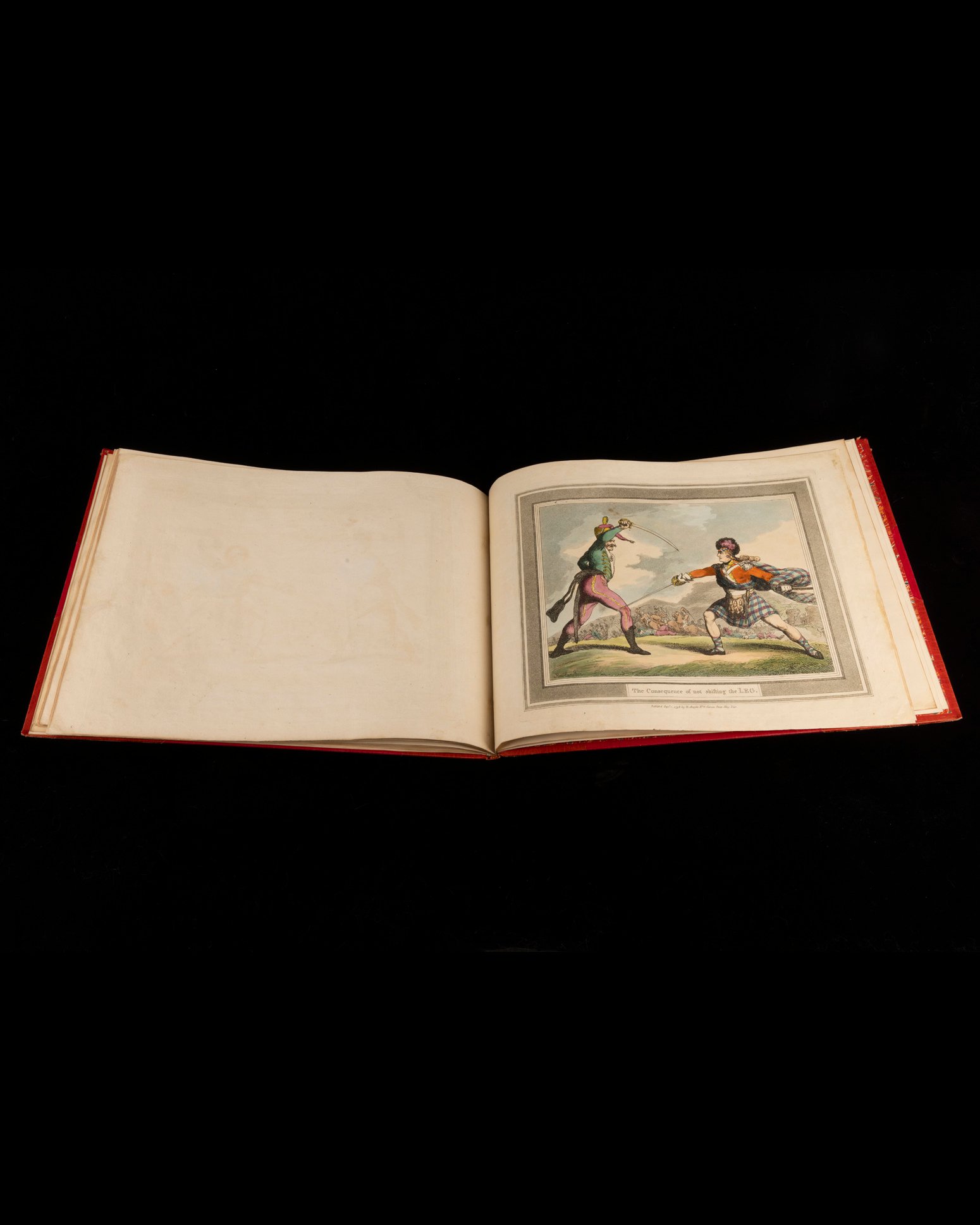Angelo Hungarian & Highland Broad Sword 1799
Rowlandson (Thomas)Hungarian & Highland Broad Sword, produced under the direction of Messrs. H. Angelo and Son, Fencing Masters to the Light Horse Volunteers, First Edition. Oblong folio, 31 by 40.5 cm. Hand-colored etched title page and 23 hand-colored etched aquatint plates
Plates are of three types -- vertical studies focused on individual combatants, horizontal pictures of two or more combatants dueling, and three plates of soldiers demonstrating various stances and/or positions. Swordsmen are shown both astride horses and on the ground. A true milestone in the fencing literature
Angelo first published his “Hungarian and Highland Broadsword” in 1799, just shortly after Roworth published his “The Art of Defence on Foot, with the Broad Sword and Sabre: uniting the Scotch and Austrian Methods into one Regular System”.
Both these works followed the 1796 publication of “Rules and Regulations for the Sword Exercise of the Cavalry” by John Gaspard le Marchant, who spent a few years visiting and observing Austrian/Hungarian light cavalry. He brought back plenty of ideas about how to improve the British cavalry, and one of his noteworthy developments was the design of the 1796 pattern light cavalry sabre
In his memoirs, Angelo claimed to have practiced using the broadsword at Newgate prison in 1798 with a Scottish friend and expert swordsman James Perry, the owner of the 'Morning Chronicle', who was then in prison for libeling the House of Lords. Angelo adapted and developed sword techniques into a series of military drills and exercises, which became the standard training for the British army infantry, cavalry and Royal Navy
Rowlandson (Thomas)Hungarian & Highland Broad Sword, produced under the direction of Messrs. H. Angelo and Son, Fencing Masters to the Light Horse Volunteers, First Edition. Oblong folio, 31 by 40.5 cm. Hand-colored etched title page and 23 hand-colored etched aquatint plates
Plates are of three types -- vertical studies focused on individual combatants, horizontal pictures of two or more combatants dueling, and three plates of soldiers demonstrating various stances and/or positions. Swordsmen are shown both astride horses and on the ground. A true milestone in the fencing literature
Angelo first published his “Hungarian and Highland Broadsword” in 1799, just shortly after Roworth published his “The Art of Defence on Foot, with the Broad Sword and Sabre: uniting the Scotch and Austrian Methods into one Regular System”.
Both these works followed the 1796 publication of “Rules and Regulations for the Sword Exercise of the Cavalry” by John Gaspard le Marchant, who spent a few years visiting and observing Austrian/Hungarian light cavalry. He brought back plenty of ideas about how to improve the British cavalry, and one of his noteworthy developments was the design of the 1796 pattern light cavalry sabre
In his memoirs, Angelo claimed to have practiced using the broadsword at Newgate prison in 1798 with a Scottish friend and expert swordsman James Perry, the owner of the 'Morning Chronicle', who was then in prison for libeling the House of Lords. Angelo adapted and developed sword techniques into a series of military drills and exercises, which became the standard training for the British army infantry, cavalry and Royal Navy
Rowlandson (Thomas)Hungarian & Highland Broad Sword, produced under the direction of Messrs. H. Angelo and Son, Fencing Masters to the Light Horse Volunteers, First Edition. Oblong folio, 31 by 40.5 cm. Hand-colored etched title page and 23 hand-colored etched aquatint plates
Plates are of three types -- vertical studies focused on individual combatants, horizontal pictures of two or more combatants dueling, and three plates of soldiers demonstrating various stances and/or positions. Swordsmen are shown both astride horses and on the ground. A true milestone in the fencing literature
Angelo first published his “Hungarian and Highland Broadsword” in 1799, just shortly after Roworth published his “The Art of Defence on Foot, with the Broad Sword and Sabre: uniting the Scotch and Austrian Methods into one Regular System”.
Both these works followed the 1796 publication of “Rules and Regulations for the Sword Exercise of the Cavalry” by John Gaspard le Marchant, who spent a few years visiting and observing Austrian/Hungarian light cavalry. He brought back plenty of ideas about how to improve the British cavalry, and one of his noteworthy developments was the design of the 1796 pattern light cavalry sabre
In his memoirs, Angelo claimed to have practiced using the broadsword at Newgate prison in 1798 with a Scottish friend and expert swordsman James Perry, the owner of the 'Morning Chronicle', who was then in prison for libeling the House of Lords. Angelo adapted and developed sword techniques into a series of military drills and exercises, which became the standard training for the British army infantry, cavalry and Royal Navy











